ReachMD
Be part of the knowledge.™Head & Neck Cancer Organoids as a Step Towards Personalized Treatments

Clinical implications
Some of the discoveries made by the team could have implications for HNC patients in the near future. For example, they showed that the drug cetuximab made the tumor organoids less sensitive to radiotherapy. Driehuis explains: “This is surprising, because the combination of this drug and radiotherapy is given to some HNC patients in the clinic today. In patients, it’s difficult to distinguish the individual contributions of the drug and the radiation therapy to the overall effect of this combination treatment, but in the organoids we can pull that apart. Our results fit with recent published data that show that survival of patients treated with cetuximab and radiotherapy is worse compared to treatment with radiotherapy alone. The clinical implication of these findings would be that it’s better to wait with cetuximab until after radiation therapy, but this change in timing of treatment is something you would need to test in patients of course.” The team also showed that a so-called PRMT5 inhibitor, a novel drug already in clinical trials for other cancer types, could be effective for a subgroup of HNC patients. Millen: “We sequencedA technique that is used by researchers to determine the genetic code of DNA or RNA. This information can be used in various ways. In disease research, sequencing may be used to trace changes in the genetic code. This could for example elucidate the cause of the disease. the DNA of the organoids, to investigate the relationship between specific genetic mutationsErrors in the DNA. Mutations can, among other things, arise if the DNA is copied incorrectly or through external influences. For example, tumor cells often contain mutations that are beneficial for their growth. and the response to treatments. By doing so, we found that tumors with loss of the geneA small piece of DNA with a specific function. For example, genes determine which color our eyes have and whether we have curly or straight hair. In a human cell, the DNA contains about 30.000 genes, each having a specific function. Genes are hereditary and can therefore be passed on to offspring.CDKN2A were responsive to treatment with this novel drug. It would be very interesting to see whether this effect is also found in patients, especially since this mutation is present in over 50% of HNSCC cases.” Driehuis concludes: “Taken together, our results highlight the clinical relevance of organoids derived from patient tumor tissue. One of the next steps would be to design a clinical trial, to really use the organoids to guide treatment decisions in HNC patients.”
This study was funded by the Oncode Clinical Proof of Concept fund.
Publication
Patient-derived head and neck cancer organoids allow patient treatment stratification and serve as a platform for biomarker validation and identification. Rosemary Millen*, Willem W.B. de Kort*, Mandy Koomen, Gijs J.F. van Son, Roan Gobits, Bas B.L. Penning de Vries, Harry Begthel, Maurice Zandvliet, Patricia A.H. Doornaert, Cornelis P.J. Raaijmakers, Maarten H. Geurts, Sjoerd G. Elias, Robert J.J. van Es, Remco de Bree, Lot A. Devriese, Stefan M. Willems, Onno W. Kranenburg, Else Driehuis and Hans Clevers. Med, 2023.
* Authors contributed equally
Facebook Comments